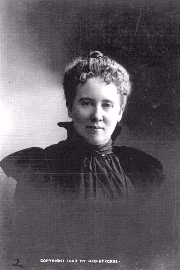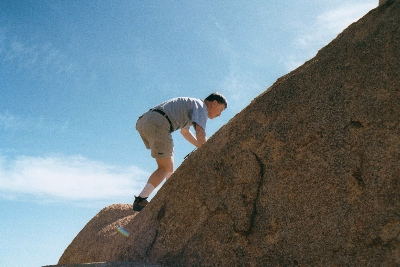|
PART
SIX - "Cochise's Rock"
| Alice Rollins Crane, upon returning
to civilization after her adventure into Apacheland with her new friend
Thomas Jeffords, wrote a letter to General Howard (as has been mentioned
earlier) suggesting that the two of them shared a great passion:
the welfare of the Apache people.
She also wrote to Joseph Alton Sladen, asking
for his version of the historically important peace mission. Sladen
wrote back, and his long letter, a point-by-point retelling of the final
weeks of the mission, was wonderfully written and glowing with detail.
He had drawn from his daily journal, which he had kept meticulously all
during the journey, fleshing out details from memory. The letter
was dated October 26,1896 -- a good 24 years after the fact. He had
been deeply affected by his visit to Cochise's camp and this fact is obvious
in the paragraphs devoted to the nearly two weeks he spent amongst Cochise's
people. He gave Crane a vivid picture of the campsite itself, although
his description of the route taken to approach it was unfortunately somewhat
obscure. |
 ALICE
ROLLINS CRANE, CIRCA 1897 -
ALICE
ROLLINS CRANE, CIRCA 1897 -
Photo
copyright George Steckel, 1897
|
Surprisingly
little has been written about this talented and adventurous woman, aside
from the fact that she once enjoyed some noteriety as a poet, authoress,
and a champion of women's rights long before her time. She was born,
by some accounts, in 1861 -- the same year that saw the beginning of Cochise's
War. We do know that she traveled to Tucson in 1895 in search of
material for a book she was planning about Native Americans. While
in Tucson she made the acquaintance of the famous Thomas Jeffords, then
in his mid-sixties, and immediately became fascinated by the Apaches, and
the 1872 peace expedition that Jeffords had led. It was one of her
bw photos, taken while camping in the stronghold with Jeffords, that eventually
found its way to this writer in 2001, and made the rediscovery of the actual
campsite possible. Crane later moved to Dawson, Alaska after divorcing
her husband, and quickly made a reputation there as one of the first lady
gold seekers to that far country. |
|
Mentioned
several times was the "big rock" that dominated the place Cochise had chosen
to erect his simple "shi-kow-ah", or house. He wrote that Cochise
spent many an hour atop this huge boulder, looking out over the vastness
of the San Pedro Valley, deep in thought -- usually smoking -- always wrapped
like a monarch in his favorite red blanket that had been given to him years
before by a prominent and savvy rancher named Colonel Hooker. Much
of the time, according to Sladen, Cochise and Tom Jeffords would sit side
by side on the "big rock", conversing infrequently in halting Spanish,
sharing a bond that has become legendary over time. The stories that
have Tom Jeffords learning to speak fluent Apache before making Cochise's
acquaintance are not accurate. It is likely, however, that he had
by this time picked up a smattering of the extremely difficult language,
and it is true that Cochise was familiar with a few English words and phrases
(at the end of General Howard's visit, as he prepared to leave the Apache
camp after successfully hammering out a peace treaty, Cochise embraced
the General and said, in English, "good-bye".)
The hand written
note on the back of the "big rock" photo that Crane sent to Howard identifies
this spot as "the big rock . . . where Captain [Jeffords] said you and
Cochise had many a talk over peace . . ." Furthermore, in her
letter of introduction to General Howard in 1895, she alludes to the photo
of the big rock and stipulates that it was upon this rock that Cochise
and Howard stood together to announce to the Indians that there would be
a peace treaty. These are concrete and undeniable testimonies that
the rock in the Crane photo was the one Sladen so often mentioned in his
memoirs (and in his letter to Crane) -- and it was "behind" this rock,
according again to Sladen, that Cochise had built his home. (From
Sladen's letter to Crane: "Soon after we
got back to camp from our visit to the top of the mountain, Cochise's wife
called me to their domicile behind the big rock . . .")
"Late
in the afternoon," writes Sladen, "Cochise,
Jeffords and myself sat on the old Chief's rock, as we called it, scanning
the distant valleys and slopes for signs of approaching parties, and smoking
and talking as we whiled the day away." This was during
a time when General Howard was absent, having been sent by Cochise to Fort
Bowie to give orders that they not be molested by troops during Howard's
visit.
___________________________________________________
|
A
Meaningful Ascent . . .

May,
2002 -- Cochise's biographer, Edwin R. Sweeney, for the first time climbs
atop the rock where Cochise is known to have spent much of his idle time.
It was a wonderful sight to behold, knowing the depth of Ed's reverence
for his subject. As I watched him make this climb, I mentally whisked
myself back to October 1, 1872, knowing that if I were standing on the
same spot then I would likely be watching Cochise himself (somewhat more
gracefully perhaps)
scaling
the boulder
PHOTO
BY GEORGE ROBERTSON, 2002
|
|

* * *

|
 .
. . . .
.
. . . . .
.
 .
. . . .
.
. . . .